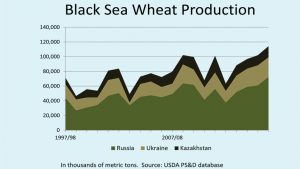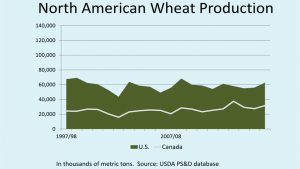World wheat outlook
SURPLUS AND SHORTAGE

WORLD WHEAT PRODUCTION topped 754 million metric tons and the world wheat supply neared 980 million tons in August estimates. Economists had raised their projections for the former Soviet Union by 8.6 million tons. With beginning stocks, that produced a world supply of 980 million tons, compared to domestic use of 736 million tons.
“Globally we have a surplus of wheat around that explains why prices continue to sink,” explains Jay O’Neil, senior agricultural economist at Kansas State University’s International Grains Program. “But while we have a surplus of wheat, we do not have a surplus of quality wheat, the good hard red winter wheat, the kind you need with the protein to make bread rise. So flour millers and bakers, especially in the United States, are scrambling quite a bit to find enough quality wheat.”
That shortage reflects two years in which Kansas’ hard red winter wheat crops were low in protein. The traditional solution is for flour millers and bakers to increase the levels of spring wheat in their products to boost protein levels.
“They look especially to the South Dakota and North Dakota wheat markets, but drought this year has affected Dakota production. It looks like we’ll have good protein levels but a smaller than expected crop,” O’Neil says. “Now they are looking to Canada. Might they have to use a little more Canadian wheat? Maybe so.”
As of press time, that was not clear, but O’Neil warns that while the industry will find enough quality wheat this year, a good crop — especially a good quality crop — will be critical in 2017/18.


INTERNATIONAL
On the international level, the Black Sea region (Russia, Ukraine, Kazakhstan, even Bulgaria) have had good crops, despite weather fears early in the year. The U.S. Department of Agriculture (USDA) reports Russian production at a record 77.5 million tons. That reflects increases in planted acres, improved yields, and improvements in agricultural practices, O’Neil says.
As Black Sea output has grown, the region has become an increasingly important competitor for export sales.
“If you go back about three months [from August], we had a price spread as high as $40 per ton in north Africa for wheat out of the Black Sea. Now we’ve seen that narrow but their wheat is still relatively cheaper, maybe by $7 or $8 per ton.”
Argentina’s crop was also looking promising, according to O’Neil. “It looks like they are going to have a big wheat crop come December, and we would expect that to come flying onto the market at fairly cheap rates,” he predicts.
EXPORT COMPETITION
Todd Austin, marketing manager for Grain Farmers of Ontario, also notes the challenges of competing for export sales.
“Once we start exporting, we are competing with the Russias, the Ukraines, the countries that can produce a whole lot of grain and sell it at a lower price than we would expect to see domestically,” he says. “The main markets we see right now are domestic and into the United States.”
“I think what Ontario producers should be watching is local demand, what their local feed mills will be offering, what the local elevators are offering,” Austin says.
He also suggests keeping an eye on the USDA’s monthly supply-demand reports for corn and soybeans. With doubts about the USDA’s August yield forecasts, Austin believes that if corn yields at harvest are down from where they were pegged there could be an opportunity for corn markets to rally.
“Because wheat is a good substitute for corn in the feed trade, that could spill over to some rallies in the wheat market,” he says.
Austin also sees merit in keeping a close eye on quality and yield developments in the Dakotas and Western Canada that could create some opportunities for Ontario’s 2018 spring wheat crop.
“We don’t necessarily see seasonal rallies by wheat by itself. It kind of follows what corn and soybean futures do, so you have to watch U.S. numbers and the Chicago Board of Trade futures as well as wheat futures to keep an eye on what’s going on in this world,” he recommends.
International supply and demand data for wheat, corn, soybeans and other crops are updated by the U.S. Department of Agriculture on a monthly basis at www.usda.gov/oce/commodity/wasde/.
To track U.S. drought conditions (updated weekly), go to http://droughtmonitor.unl.edu/. •

























